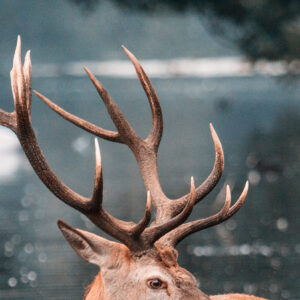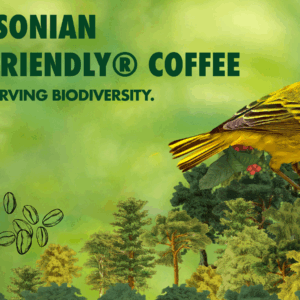Nature at My Doorstep: Stinkin’ cute skunks
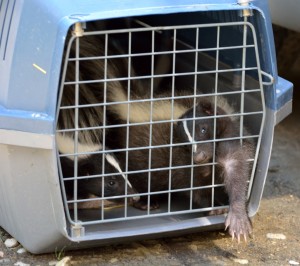 Skunks! You might not believe it, but I agreed to release some young skunks onto our property. Insane? Perhaps, but I’ll let you be the judge!
Skunks! You might not believe it, but I agreed to release some young skunks onto our property. Insane? Perhaps, but I’ll let you be the judge!
Most of us know skunks only as smelly-critters that have succumbed to motor vehicle collisions or who have “viciously attacked” our outdoor pets. We pinch our noses and hope the smell dissipates quickly, maybe cursing a bit.
Skunks have a much better side though, and if you have a chance to watch one for a while, you might decide these little mammals are worth having around.
Skunks are primarily nocturnal, opportunistic foragers. That means they are active at night and eat almost anything. They are GREAT to have a garden or agricultural area because they eat pests, including mice, grasshoppers, grubs and slugs. They will also help scavenge other dead animals. They eat berries, mushrooms and other foods they find on the forest floor.
They are a (mostly) beneficial component of a balanced ecosystem. So why the bad rap?
[separator headline=”h2″ title=”Much Maligned”]
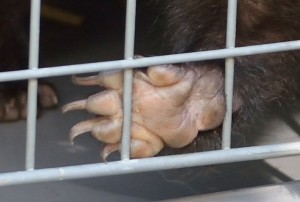 If skunks are so great, why the reputation? Beyond the odour produced by the scent glands, the skunk’s niche as an opportunistic forager sometimes conflicts with human agricultural practices and human behaviours.
If skunks are so great, why the reputation? Beyond the odour produced by the scent glands, the skunk’s niche as an opportunistic forager sometimes conflicts with human agricultural practices and human behaviours.
Skunks eat eggs. Part of their natural diet includes ground-nesting bird eggs and nestlings. In a balanced ecosystem, they eat a small portion of these, and help keep populations in check. Unfortunately if you have a farm and are raising fowl, the eggs and chicks become easy targets if they aren’t properly protected. Skunks are well adapted for digging and squeezing through small openings.
They are the perfect blend of cat and weasel, and as such, pen or coup designs should take predators into consideration (including foxes, coyotes, domestic cats and weasels.) If the opportunity is provided, opportunistic foragers eat what is readily available. If we remember that they are doing what comes naturally rather than being “malicious” or “sneaky”, or even planning their attack we can be much more prepared and tolerant of their presence.
[separator headline=”h2″ title=”Skunk Spray Behaviours Explained”]
Beyond the feeding and foraging issues that can arise, skunks also have an infamous defense mechanism…the foul smelling spray. Most of us are familiar with the smell, but may not be aware that this is a costly last resort for the skunk. Things to know about skunks:
1. Skunks are timid and avoid conflict.
a. They will not typically be the aggressor in a chance meeting.
b. They will not chase you down specifically to spray you.
c. They will (usually) give warning, like most mammals, if you are too close, before they spray.
2. Skunks have a GREAT startle reflex.
a. This is the main problem. If you, your dog or cat come across a skunk at night (or in the day), you likely see them before they detect you.
b. If you are thinking, you will quietly back away, trying not to startle the little critter further than you have. They will usually turn, raise their tail and pause, waiting for you to leave, or may come to investigate the noise.
c. Once you are detected, the skunk may warn you by stomping, or turning with its tail raised. This doesn’t necessarily mean it will spray, but don’t take chances.
d. Your dog or cat likely ignores these warnings, often resulting in a spraying.
Have a look at the warning this little skunk gives me.
3. Skunks have poor eyesight.
a. As a nocturnal forager, they rely heavily on their senses of smell and hearing to hunt.
4. Skunk spray is expensive for the skunk.
a. Like many defense mechanisms, it takes energy and time to replenish, and thus is precious to the skunk.
b. Adult skunks’ scent glands may hold enough to spray five or six times, but once emptied, can take ten to fourteen days to replenish.
[separator headline=”h2″ title=”The Release”]
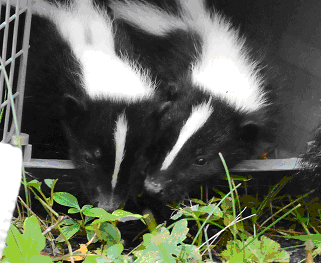 Knowing about skunks, their behaviours and benefits, I agreed to release a small “litter” of them onto our property. We are adjacent to a natural wildlife corridor, and there is a large natural habitat for them. They should be successful in this area.
Knowing about skunks, their behaviours and benefits, I agreed to release a small “litter” of them onto our property. We are adjacent to a natural wildlife corridor, and there is a large natural habitat for them. They should be successful in this area.
Seven skunks, three from the same litter, were packaged up for transport. I was a bit leery of having them in my car, but any spraying was done before I collected them so they weren’t too smelly in the car. Once removed from the car, the little guys were anxious to get out of their cages.
After scouting the perfect spots for two separate releases, the skunks were transported deep into the forest and released. Their release site was near water, and densely forested, with many potential den sites and plenty of food sources.
[separator headline=”h2″ title=”A Happy Ending”]
Skunks are often killed because of their proximity to humans, and this leads to numerous orphans. If left in the wild, young orphans typically perish without parental care and protection. The establishment of Wildlife Rehabilitation societies, like the one in Edmonton, provide an opportunity for the orphans to be cared for and relocated to areas where they become important components in a balanced ecosystem.
 This article was contributed by guest blogger, Shauna Howerton.
This article was contributed by guest blogger, Shauna Howerton.
Born and raised a nature lover in Edmonton, Alberta, Shauna now lives near Chickakoo Lake in Parkland County, Alberta. A science teacher by profession, Shauna’s hobby time is spent tending and photographing the nature surrounding her. “Moving from the city to a rural area has been an eye-opener, and has provided me with unbelievable learning experiences that can be applied no matter where you live.”
Shauna’s photography work can be found at shaunastevens.500px.com. You can also connect with her on Twitter at@shaunashome or on Facebook at facebook.com/ShaunasHome.

